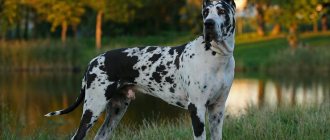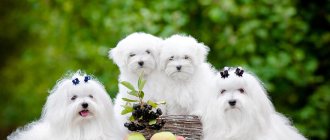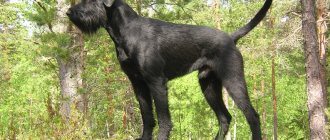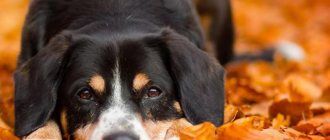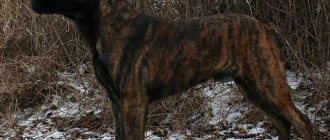| Intelligence: |
| Aggressiveness: |
| For security: |
| For children: |
| Training: |
| Difficulty in care: |
The Danish Broholmer (Brogolmer) or Danish Mastiff is a very ancient European breed of dog. Based on the results of archaeological excavations, it was established that large mastiff-like dogs accompanied the Vikings during their military campaigns about two thousand years ago. It is these ancient Molossians who are the ancestors of modern mastiffs, Great Danes and, accordingly, Broholmers.
a guard for castles and estates in the Middle Ages . In addition, dogs took part in hunting wild boars, deer and even bears. Due to their endurance and strength, Danish Mastiffs were used as draft power by farmers. Dogs have also proven themselves to be good guards and livestock herders. The breed received its development and formation in the 19th century thanks to the works of a royal huntsman named Sehested, who lived on the island of Funen in Denmark. He decided to select the best representatives of this breed to further improve the qualities of the dogs. It was then that the breed got its name in honor of the Broholm estate, where Sehested was breeding dogs.
It is a known fact that the Danish king Frederick VII kept several broholmers at court. That's why this dog is called the "royal dog" in Denmark. Unfortunately, in the 20th century there was a sharp decline in the number of these dogs. Today, representatives of the Danish Broholmer breed can be found in Denmark, the Netherlands, Sweden, Germany, Finland and very rarely in other countries.
Appearance
The Danish Broholmer is a large dog with proportional body parts. The head is large, with a relatively short muzzle. Drop ears are set high on the head. The eyes are almond-shaped and dark brown. The nose is quite large and black. The neck of dogs is wide and of medium length. There is a small fold of skin in the throat area. The transition from neck to withers is smooth.
The chest is well developed. The back line is almost straight, with a slight slope towards the tail. The fore and hind limbs are long, straight, and muscular. The hock joints are well developed. The tail of the Broholmer is saber-shaped and quite thick. When at rest, the tail hangs down; when moving, the dog holds it at mid-thigh level. The Broholmer's coat is short, stiff, and lies tightly to the body. On the ears the covering is smoother and silkier.
Color
The color of the Danish Mastiff can range from light beige to deep red with or without a black mask on the face. There are black dogs with white spots on the paws, tip of the tail and chest.
Story
Broholmer (Brokholmer) is an old Danish dog, a descendant of the fighting dogs of the ancient Germans. These powerful dogs gave rise to many mastiff breeds in Europe. From them came the name “Great Dane”, which outside Germany mistakenly means Great Dane. Purebred breeding of Broholmer began at the end of the nineteenth century by the court huntsman of the Broholm-Fyn estate. He selected dogs throughout the country that, in his opinion, corresponded to the characteristics of the breed, and on this basis he established purebred breeding. Broholmers were very popular in their homeland, they were used as baiting dogs for hunting deer and large animals, in particular bears and wild boars, and also as watchdogs. During the Second World War, the Broholmer almost completely disappeared, but by 1975 a group of breeders led by dog handler U. Weiss, who later founded the Danish Kennel Club, carried out extensive work to restore the breed. At the moment, Brogolmer is well known outside of Denmark.
Content
The Danish Mastiff requires a lot of space to live comfortably. The ideal place to keep a dog is a country house with a spacious yard. If the housing is located within the city, the owner of the Broholmer must devote at least 2-3 hours a day to walks and active activities with his pet.
Masti gets along well with other pets, but it is not recommended to get this breed when there is already another dog in the house, especially if it is two males.
Harrier price
Before you buy a Harrier, you should prepare for its appearance in the house. Buy bowls, a collar, a rug, a leash. This is the minimum set. You may also need combs, since you need to get used to this procedure from puppyhood. The dog sheds a lot.
There is no point in purchasing an animal before it is 3 months old. If we are talking about the pet class, then the place of purchase does not matter. But for breeding and show-class dogs that you plan to take to exhibitions and participate in competitions with, you need to take a closer look at a specialized nursery. It is better to ignore buying from hand. The price of a harrier starts from 37 thousand rubles. The cost is influenced by pedigree, gender, and class.
Nutrition
For proper and healthy development, any dog needs to eat well. The Danish Broholmer, as a Molosser, must consume a balanced combination of proteins, fats and carbohydrates daily. For proteins, you should give your dog boiled lean chicken, turkey or beef, as well as offal. Broholmers enjoy eating cottage cheese and boiled eggs, which contain healthy fats. Grated fresh carrots, apples, and beets will supplement your dog’s diet with vitamins.
Feeding your pet with dry ready-made food for large breeds can be a convenient alternative, since modern dog food contains all the necessary ingredients. Therefore, the owner of a broholmer can choose any of the methods.
Broholmer care
The basic principles of caring for a sluggerhound are dictated primarily by its large size and body features. The owner of a confident dog should follow these guidelines:
- Balanced diet. Feed for broodmares should be of good quality and consist mainly of meat. However, for this particular breed, adequate calcium is extremely important, especially during the growing period. A sufficient supply of this element can be ensured by enriching the natural diet with quark meat, crushed shells of hard boiled eggs and special vitamin and mineral supplements. For most owners, it is easier to feed a large dog dry food, with special attention paid to its quality and suitability for a large breed. There are no specific dietary restrictions, but there are general prohibitions on sweets, meat, spicy foods, pipes and fish bones.
Crushed eggshells are a source of calcium, essential for large breeds. - Hair care. Our special rubber brush or glove designed for short-haired animals is the best way to remove loose hair. Teeth brushing should be done once a week, but during the shedding period - daily. Bathing should be done as needed, but grooming is not required.
- Ear care. Floppy ears should be checked regularly for damage, dirt and redness.
- Personal space. A dog of this breed can be kept in an apartment, but it is better if the apartment is spacious. The large size of the breeding stock dictates the amount of space required. The animal must have a sleeping place and it must be protected from drafts, as they are dangerous to the health of the joints.
- It is necessary to walk daily and for long periods of time. Despite their size, dogs are active and should be given an outlet for their energy.
- Training is required. Primates, as a rule, are reluctant to follow commands, so the owner will need persistence and confidence in his actions. Some stubbornness does not mean ineffectiveness, as this breed is trainable. A course of socialization and discipline for the dog is necessary. It is necessary to constantly follow the rules and not give concessions.
Breed photo
Character traits
The Great Dane is endowed with an easy-going character and excellent, courteous manners. This is not always easy to believe, given the impressive exterior characteristics of an adult animal. Thus, the dog’s appearance can be somewhat misleading, instilling thoughts about the aggressive nature of the dog. In fact, Great Danes are one of the most peace-loving and non-conflict breeds, capable of adequately assessing the situation and not prone to unreasonable aggression.
Unlike an adult animal, which behaves in a balanced and relaxed manner, young animals can show quite a lot of hyperreactivity and, in some places, a serious degree of disobedience. This should not be alarming, since timely and attentive upbringing of the puppy can, over time, neutralize the shortcomings described above. After proper socialization, the Great Dane turns into a confident, predictable pet, which, on the one hand, will not raise or raise its voice without reason, but, on the other hand, without excessive emotionality, will firmly stand up for the protection of people close to it.
The future owner of this breed should be aware that Great Danes are very social animals. Therefore, its owner must be ready to provide the dog with due attention, since this animal is an extremely sociable individual and for the normal development of the dog it is extremely important that it feels like a full member of the family. Although, it is worth noting that the Great Dane is not inclined to be intrusive and will not disturb its owner without reason.
Buying and choosing a puppy
Today, the Danish Broholmer is a very rare breed, and almost all of its representatives are found in northern European countries. However, if you really want to, you can purchase a puppy by contacting foreign breeders, or by visiting exhibitions. Prices for Danish Broholmers are justifiably high, since this breed was revived with great difficulty, but their numbers are still relatively small. A Danish Mastiff puppy can be purchased for an amount of at least 100 thousand rubles.
Broholmer's diseases
Among large dogs there are very few long-livers; Danish Brojoliers live only 10-12 years. Particular attention should be paid to the cardiovascular system and musculoskeletal system of the dog. Common health problems include:
- Hip dysplasia. This is usually a hereditary problem that appears before the age of one and a half years, when the dog begins to limp and has difficulty standing up or walking up stairs. The disease can lead to immobility of the animal, so it is important to consult a doctor promptly. Treatment in most cases is surgical.
- Inflammatory joint diseases and limb fractures. Puppies are especially susceptible to this type of problem because their musculoskeletal system is very sensitive during the growing period. Any stiffness or difficulty walking or running should be a signal for the owner to seek medical help. As a preventive measure, experts recommend not to overload the growing body with excessive loads, not to allow the mare to swim a lot (especially in cold water), sleep in drafts or jump from great heights.
- Heart failure. Large body sizes often lead to rapid wear and tear on the cardiovascular system. Dangerous symptoms include a bluish discoloration of the tongue, heavy breathing and loss of consciousness. Treatment is prescribed by a veterinarian after a specific diagnosis has been made and is usually pharmacological.
Whom to choose?
It is important to note that Great Danes should be chosen only by people who are financially secure and capable of keeping such a large animal in decent conditions. There must be a spacious house and a walking area, as well as timely medical assistance if necessary.
Great Danes are very intelligent, calm and balanced, but they love to dominate and are difficult to deal with if you do not undergo training and an obedience course in time. Only an experienced and confident person can handle such a dog. At the same time, properly trained dogs are careful and responsive, ready to make any sacrifice for the sake of their family members.
The breed is beautiful in appearance
People around them always pay attention to Great Danes, not only because of their size, but also because of their royally proud posture and look. They behave with great dignity in any situation
Breeding
Only absolutely healthy representatives without burdened heredity are suitable for breeding. Nervous, aggressive individuals are dangerous to others, so they should not breed. Illiterate breeding is dangerous for the lives of puppies. It also negatively affects the status of the breed among its admirers.
Nervous, aggressive individuals are dangerous to others, so they should not breed
Many specialized nurseries are engaged in breeding Spanish Mastiff puppies, which can be found even here. The purity of the dog breed offered by breeders is not in doubt, because professionals supervise the breeding, as well as compliance with all rules. And if necessary, the kids receive veterinary care.
Purchase and price
If you decide to buy a puppy, then look for a conscientious breeder. You can ask your friends, collect real reviews. View the pedigree of your future pet. Study its appearance carefully. Choose a puppy that is more than 2 months old.
The baby should have soft fur, clean ears, and a wet nose. Observe his behavior. The dog should be active, but without showing aggression.
The cost is quite high - from 600 US dollars for the simplest representatives without a pedigree. There are also more expensive pets, the price of which exceeds $1,000. Such puppies have a good pedigree, they can participate in exhibitions and also in breeding
The baby should have soft fur, clean ears, and a wet nose.
Psychological picture
Outwardly, this is a calm, peace-loving dog, never intrusive. It seems that the tornak is lazy and apathetic, but at the slightest threat the dog is lightning-fast ready for defense and fight. It is foolish to question the endurance of the Bosnian Tornjak; these dogs can work in any weather, at any temperature.
They love their owners, are emotional in their presence, but not intrusive. The Bosnian Tornjak has pronounced leadership qualities. He loves to do the work assigned to him.
Dogs of this breed are strong and resilient. The Bosnian Tornjak is by nature undemanding, serious, calm, non-aggressive and self-confident. He is always on guard and ready to show his protective qualities in case of danger.
He behaves warily with strangers, but not aggressively. With the owners he is emotional and friendly.
Great Dane training
Many people will find it strange that it is extremely rare to meet a Great Dane owner with a pet on training grounds. Yes, these dogs have natural intelligence, but this does not exempt them from training and socialization. The owner of a puppy of this breed should take into account that an uncontrollable giant strong dog will create more significant problems than a poorly trained Yorkshire Terrier.
If the puppy ends up with an inexperienced dog breeder, then it is worth attending professional training classes, and the presence of the owner is mandatory. This will allow you to find the right approach to your pet, and the dog will learn to listen to the owner. Training will require a lot of patience; any manifestations of cruelty are prohibited. Physical methods can cause the dog to be overly fearful or aggressive.
The Great Dane can be influenced by voice, since purebred representatives are very sensitive to intonation changes. You can start training a Great Dane puppy at 2 months of age. First of all, the baby must learn a set of mandatory commands, and this happens quite quickly. A few days are enough for the pet to understand what is required of him, and he will diligently do everything, trying to please the owner. After this, you can proceed to more complex commands. It is important to use various methods of encouragement - treats, praise and approving glances can encourage your pet to learn.
